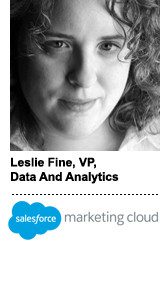 Some of Salesforce Marketing Cloud’s new products, rolled out Wednesday, seem to mimic the capabilities of a data management platform (DMP) – software historically absent from the stack.
Some of Salesforce Marketing Cloud’s new products, rolled out Wednesday, seem to mimic the capabilities of a data management platform (DMP) – software historically absent from the stack.
Salesforce’s Predictive Scores and Predictive Audiences are designed to help marketers segment and target prospects and known consumers with more speed and granularity.
Those two tools fall under new product Predictive Journeys, an “advanced data and analytics” engine intended to help marketers blend CRM data with data from things like web browsing, email and in-app engagement.
“A lot of people are approaching machine learning like a black box, and we really believe in exposing the underlying factors contributing to that,” said Leslie Fine, the VP of data and analytics for Salesforce Marketing Cloud. “At a glance, you can see what’s driving likelihood to purchase, what’s taking away from it and pull in first-party, third-party data and understand some of the causal aspects of an action.”
For instance, if a consumer downloaded a retailer’s mobile app, to what extent did that improve their likelihood to purchase?
From there, a marketer can assign predictive scores to prospects or existing customers based on how likely they were to unsubscribe from a newsletter, open an email, click on a display ad or download the mobile app.
“You can take these scores and segment audiences more effectively because someone who enters the purchase funnel responding to a coupon has a very different mindset than someone who opens an email regularly from me,” Fine said.
Additionally, Salesforce says its audience segmentation engine gets smarter as it collects more data points throughout a consumer journey.
For instance, consumers who tend to sign up for a newsletter and unsubscribe may trigger a “service-oriented” path, which reduces marketing message volume. Or those messages might offer the chance to speak with a call center agent.
Shopping site Rue La La, which has 16 million members (70% of whom engage with its site or app via a mobile device), has members who buy once or twice then go dormant.
Using Predictive Journeys and Audiences, Rue La La created different segmentation scenarios.
For instance, Rue La La might email a $10 credit toward the next purchase for a user who downloads the mobile app for the first time.
“Although we’re focused more on known customers like in the case of Rue La La, DMPs are great when you don’t know who your audience is and we definitely think there are interesting ways this can be used in the ad space,” Fine said.
“You can easily take this predictive score and apply it to a Facebook news feed,” she said, and added that a marketer could “customize ads for someone with a high propensity to purchase by pushing a limited-time coupon or related call to action in the news feed.”
Update: Salesforce also reported its quarterly earnings on Wednesday. Revenue for the Marketing Cloud grew 22% year over year in the third quarter to $169 million, up from $131.5 million last year. Total revenue for the company in the third quarter was $1.71 billion, a 24% increase YOY.
Correction: The article earlier stated that 10 million of Rue La La’s members are through its mobile app; the correct figure is 70% of its total 16 million members access its site or apps from a mobile device.











